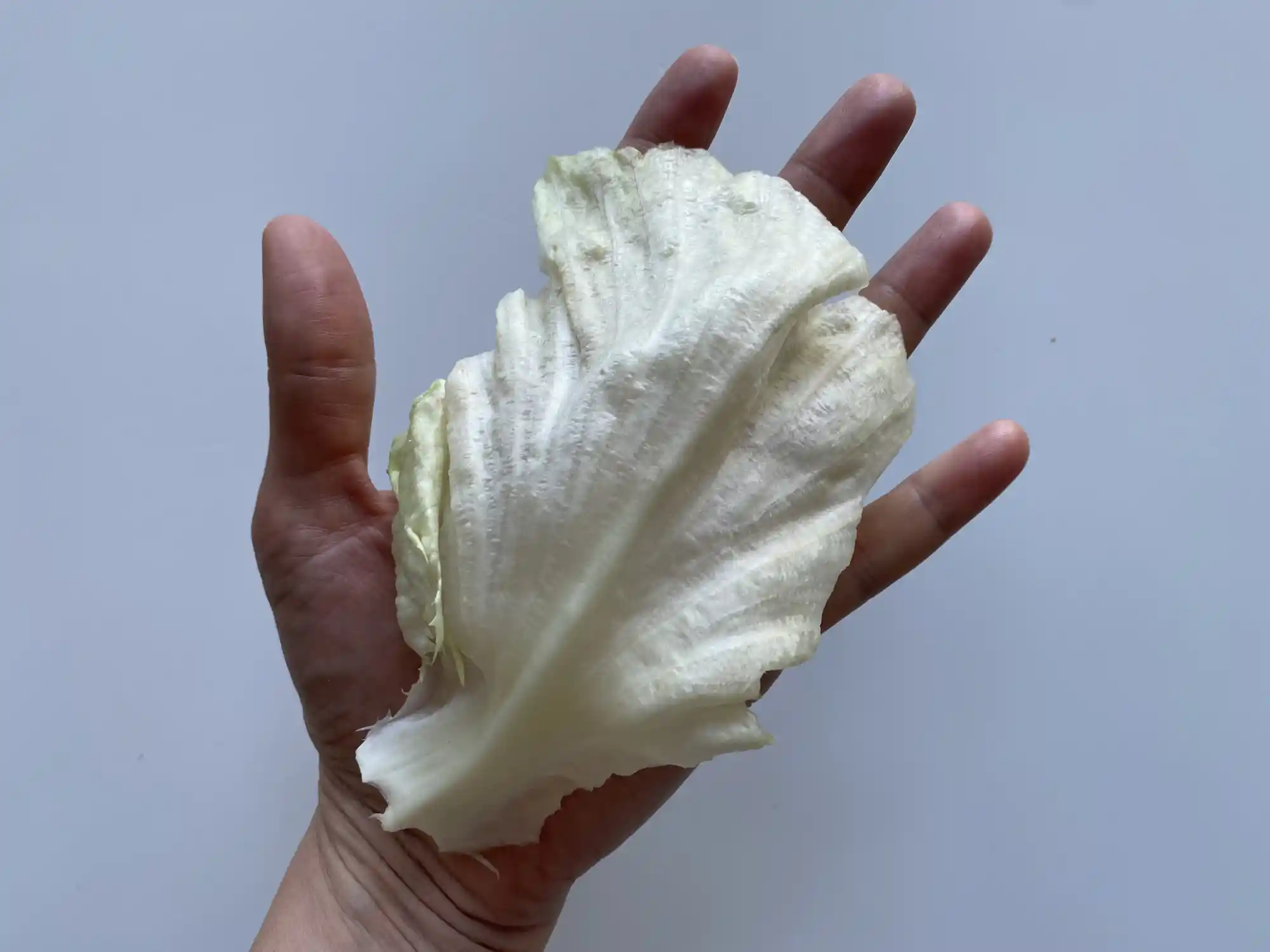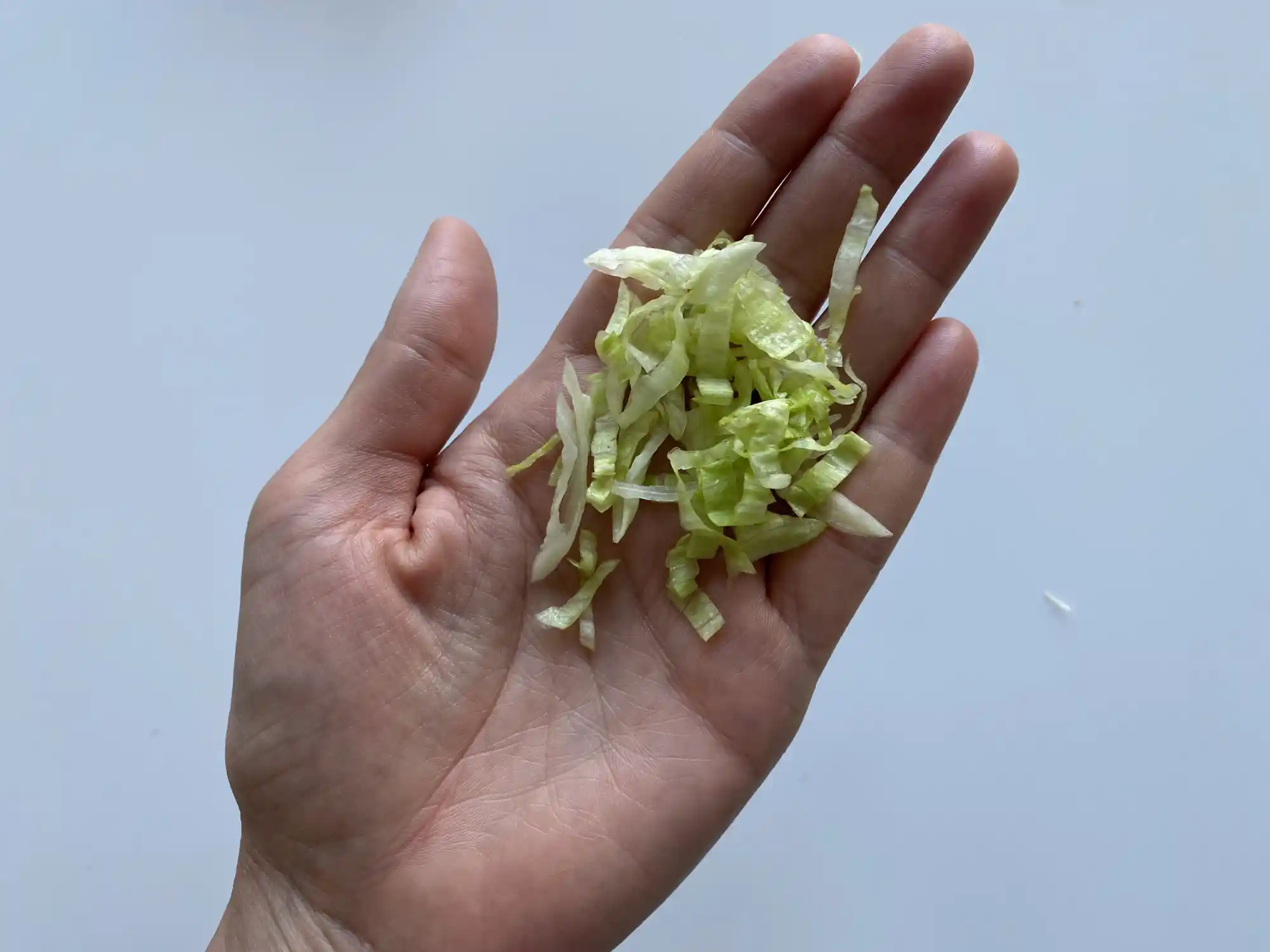Access our First Foods® Database in the Solid Starts App.
Learn moreIceberg Lettuce
Vegetable
Age Suggestion
6 months
Iron-Rich
No
Common Allergen
No

When can babies eat iceberg lettuce?
Iceberg lettuce may be introduced as soon as baby is ready to start solids, which is generally around 6 months of age. That said, chewing and swallowing lettuce can be tricky for the youngest eaters, so check out our serving suggestions by age.
How do you prepare iceberg lettuce for babies with baby-led weaning?
Every baby develops on their own timeline, and the suggestions on how to cut or prepare particular foods are generalizations for a broad audience.
6 months and up:
Offer large iceberg lettuce ribs, the thicker, paler leaf stems that grow from the head’s core. Baby is not likely to bite, chew, and swallow lettuce, but rather munch and teethe on it, which is beneficial in developing oral-motor skills. If they break or bite off pieces of the rib, simply wait for them to spit them out, then take the piece away. You can also finely shred cooked iceberg lettuce and mix it into scoopable foods. Introducing green foods into baby’s meals early and regularly may help to prevent refusal of greens later on.
9 months and up:
Offer finely chopped or shredded iceberg lettuce (the firm rib or the leafy part, raw or cooked) to encourage use of the pincer grasp (where the index finger and the thumb meet). Greens can easily cling to the back of the roof of the mouth of babies and adults alike. Tossing the greens with a homemade dressing can help move along any bits that may get stuck. You can also offer a small amount of water in an open cup to help wash them down. Alternatively, you can continue to serve large lettuce ribs for biting and tearing practice.
12 months and up:
Serve chopped or shredded iceberg lettuce, cooked or raw, either as finger food or to encourage utensil practice. In addition, you can continue to serve large pieces of iceberg lettuce for the child to practice biting and tearing. Eat alongside the child to model how it’s done, show them how to dip the lettuce into dressing, and if a toddler refuses the greens, try not to apply pressure, and don’t write off the food entirely. Toddlers cannot learn to enjoy foods if they are not offered to them, so even if you don’t think your toddler will explore a dish with leafy greens, serve it anyway so they can get used to greens being part of a meal.


Preparing iceberg lettuce for babies 6 months+
How to prepare iceberg lettuce for toddlers 12 months+
Learn how to interest kids in trying new foods in our guide, 25 Ways to Help Kids Taste Proteins & Vegetables.
Videos
Is iceberg lettuce a common choking hazard for babies?
No. Iceberg lettuce is not a common choking hazard, though small shreds of lettuce carry a risk of aspiration (when food or fluid accidentally enters the airway but does not block it). Lettuce can also be quite tricky to manage for the youngest eaters,leading to gagging if the leaves cling to the roof of the mouth or baby’s tongue. Offer a drink in an open cup to help baby wash any pieces of food down. As always, make sure to create a safe eating environment and stay within an arm’s reach of baby during meals. For more information on choking, visit our sections on gagging and choking and familiarize yourself with the list of common choking hazards.
Is iceberg lettuce a common allergen?
No. Allergies to lettuce are rare, though when they do occur, they can be severe. Individuals with lettuce allergy may be sensitive to lipid transfer proteins in other foods such as peach, cherry, carrot, grape, corn, hazelnut, peanut, and walnut. However, it is not typical for people with lettuce allergy to react to all these other foods. Individuals with Oral Allergy Syndrome (also called pollen food allergy syndrome), and in particular, those with sensitivities to plane tree pollen, may also be sensitive to lettuce. Oral Allergy Syndrome typically results in short-lived itching, tingling, or burning in the mouth and is unlikely to result in a dangerous reaction. Cooking lettuce may help minimize and even eliminate the reaction.
As you would when introducing any new food, start by offering a small quantity on its own for the first few servings. If there is no adverse reaction, gradually increase the quantity over future meals.
Is iceberg lettuce healthy for babies?
Yes. Iceberg lettuce provides lots of water and important nutrients for a developing child, including vitamin A, folate, potassium, vitamin K, fiber, and lutein and zeaxanthin. In tandem, these nutrients work to support vision, heart health, healthy blood, and a healthy digestive system.
Lettuce may be contaminated with foodborne illness-causing germs, such as E. coli, Salmonella, and Listeria. Wash lettuce thoroughly under cold running water (no need for soap or vinegar) before serving or cooking with it.
★Tip: To get the most value, purchase a whole head of lettuce, store loosely wrapped in a paper towel in the crisper drawer of your fridge, and don’t wash the leaves until mealtime.
Can iceberg lettuce help babies poop?
Yes. Iceberg lettuce contains fiber and water, both of which support healthy digestion and regular pooping. Note that pooping patterns can vary significantly from child to child. Be sure to talk to your pediatric healthcare provider if you have concerns about baby’s pooping and digestive function.
Where does iceberg lettuce come from?
Iceberg lettuce was developed in the United States from Mediterranean varieties in the 20th century. Its name recalls preservation methods before refrigeration; heads of lettuce were packed on ice in freight train boxcars as they traveled from California farms to markets across the country. Iceberg lettuce has gone in and out of style over the past 100 years, but it lives on as a mainstay on dinner tables and restaurant menus alike. Iceberg lettuce is refreshingly cool, with a crisp texture, a watery sweetness, and just a hint of bitter bite. This lettuce is part of the crisphead family—varieties whose leaves grow to overlap one another to form a dense, round head that looks very different from loose-leaf greens like arugula, kale, and spinach.
Our Team
Written by
Expert Tips Delivered to Your Inbox
Sign up for weekly tips, recipes and more!
Copyright © 2026 • Solid Starts Inc







